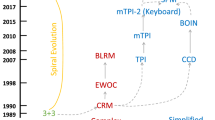Abstract
Most statistical methods for dose-finding in phase I clinical trials determine a maximum tolerable dose based on toxicity while ignoring efficacy. Most phase II designs assume that an acceptable dose has been determined and aim to estimate treatment efficacy, possibly with early stopping rules for safety monitoring. The purpose of this paper is to describe a new statistical strategy for dose-finding in single-arm clinical trials where patient outcome is characterized in terms of both response and toxicity. The strategy, which may be considered a phase I/II hybrid, was first proposed by Thall and Russell [1] and subsequently modified by Thall [2]. The underlying mathematical model expresses the probabilities of response and toxicity as interdependent functions of dose. The method is based on fixed standards for the minimum probability of response and the maximum probability of toxicity appropriate for the particular trial. The best acceptable dose is chosen for each successive patient cohort adaptively, based on the fixed standards and the dose-outcome data from patients treated previously in the trial. The scientific goals are to select one best acceptable dose for future patients and to estimate the response and toxicity probabilities at that dose, or to stop the trial early if it becomes sufficiently unlikely that any dose is both safe and efficacious. An application of the method to a trial of donor lymphocyte infusion as salvage therapy for chemo-refractory AML/MDS patients is described. To illustrate the method's flexibility and potential breadth of application, two additional examples are provided, including a hypothetical trial in which a 5% response rate is of interest.
Similar content being viewed by others
References
Thall PF, Russell KE: A strategy for dose-finding and safety monitoring based on efficacy and adverse outcomes in phase I/II clinical trials. Biometrics 54: 251–264, 1998
Thall PF: Safer Bayesian dose-finding based on efficacy and toxicity in early phase clinical trials. Unpublished manuscript
Storer BE: Design and analysis of phase I clinical trials. Biometrics 45: 925–937, 1989
O'Quigley J, Pepe M, Fisher L: Continual reassessment method: a practical design for phase I clinical trials in cancer. Biometrics 46: 33–48, 1990
O'Quigley J, Shen LZ: Continual reassessment method: a likelihood approach. Biometrics 52: 673–684, 1996
Korn EL, Midthune D, Chen TT, Rubinstein LV, Christian MC, Simon RM: A comparison of two phase I trial designs. Statistics in Medicine 13: 1799–1806, 1994
Møller S: An extension of the continual reassessment methods using a preliminary up-and-down design in a dose-finding study in cancer patients, in order to investigate a greater range of doses. Statistics in Medicine 14: 911–922, 1995
Goodman SN, Zahurak ML, Piantadosi S: Some practical improvements in the continual reassessment method for phase I studies. Statistics in Medicine 14: 1149–1161, 1995
Thall PF, Lee JJ, Tseng C-H, Estey EH: Accrual strategies for phase I trials with delayed patient outcome. Statistics in Medicine 18: 1155–1169, 1999
Freireich EJ, Gehan EA, Sulman D, Boggs DR, Frei E III: The effect of chemotherapy on acute leukemia in the human. J Chronic Disease 14: 593–608, 1961
Shen Y, Thall PF: Parametric likelihoods for multiple nonfatal competing risks and death. Statistics in Medicine 17: 999–1016, 1998
Estey EH, Shen Y, Thall PF: Effect of time to achieve CR on subsequent survival time in patients with newly-diagnosed AML, RAEB-t, or RAEB in whom response is established after the first course of chemotherapy. Blood, In press
Thall PF, Simon R: Recent developments in the design of phase II clinical trials. In: Thall PF (ed) Recent Advances in Clinical Trial Design and Analysis. Kluwer, Boston, 1995 pp 49–71
Thall PF, Simon R, Estey EH: Bayesian sequential monitoring designs for single-arm clinical trials with multiple outcomes. Statistics in Medicine 14: 357–379, 1995
Press J: Bayesian Statistics: Principles, Models, and Applications. Wiley, New York, 1989
Berry DA: Monitoring accumulating data in a clinical trial. Biometrics 45: 1197–1211, 1989
Berry DA: A case for Bayesianism in clinical trials (with discussion). Statistics in Medicine 12: 1377–1404, 1993
Gelman A, Carlin JB, Stern H, Rubin DB: Bayesian Data Analysis. Chapman and Hall, London, 1995
Berry DA, Stangl DK (eds): Bayesian Biostatistics. Dekker, New York, 1996
Author information
Authors and Affiliations
Rights and permissions
About this article
Cite this article
Thall, P.F., Estey, E.H. & Sung, HG. A New Statistical Method for Dose-Finding Based on Efficacy and Toxicity in Early Phase Clinical Trials. Invest New Drugs 17, 155–167 (1999). https://doi.org/10.1023/A:1006323317135
Issue Date:
DOI: https://doi.org/10.1023/A:1006323317135




